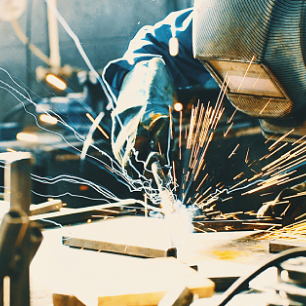Jump to:
The Answer Is
This is the second part of my response to the inquiry about reducing elongated porosity in welds made using the flux cored welding process. Part 1 appeared in the August 2025 Inspection Trends. This installment focuses on setting welding parameters to achieve the best possible results.
A quick review of the construction of flux cored electrodes and the functions of the flux is a good starting point. These electrodes consist of a tubular wire formed from a strip of sheet metal filled with the proper amount of flux. The flux inside the electrode sheath provides improved deoxidation compared to the bare wire used for gas metal arc welding. Similar to the covered electrodes used in shielded metal arc welding, the flux produces copious volumes of carbon dioxide smoke, which displaces the air around the molten weld pool. It also supplies the elements needed to form a slag cover and improves the weld profile. Additionally, the flux can serve as a vehicle for alloying elements to tweak the chemistry of the weld deposit. However, the limited volume of flux in the electrode core makes the welding process somewhat sensitive to welding parameters.
There are two types of flux cored arc welding (FCAW) electrodes: gas shielded and self shielded. Typically, small-diameter electrodes cannot produce sufficient carbon dioxide to properly shield the molten weld pool, so additional shielding gas is required to supplement the carbon dioxide produced by the electrode. Larger-diameter electrodes, which contain more flux, may be able to produce larger volumes of carbon dioxide and therefore do not require additional shielding gas. The supplemental shielding gas usually consists of carbon dioxide or a mixture of carbon dioxide and argon in varying proportions. Mixed gases with higher argon content tend to reduce weld spatter and increase tensile and yield strength, often at the expense of ductility.
Electrode manufacturers have wide latitude in the composition of the flux and the fill factor (i.e., the amount of flux in the electrode core) as long as they can demonstrate the requirements of the filler metal specification and classification are met. In other words, not all FCAW electrodes are created equal. To achieve optimal mechanical properties and performance, proper welding parameters must be used. Considering each electrode manufacturer has complete control over the chemistry of their electrodes, it should come as no surprise that the parameters producing excellent results for one brand may not yield the same performance with another even when both electrodes carry the same AWS classification.
There are four key welding parameters that must be controlled to achieve acceptable results: arc voltage, wire feed speed, welding current, and electrode extension. Each of the parameters must fall within a tight range to get the right balance for optimal performance. While your employer could determine the ideal parameters through endless trial and error, and if they have deep pockets and plenty of time, they’re welcome to do so. My question is: Why replicate what the manufacturer has already done?
Most manufacturers list recommended parameters for optimum results on their websites. If the manufacturer doesn’t provide that information, look for a different manufacturer.
Let’s look at the four parameters I listed and how they influence the welding operation:
- Arc Voltage: This is the voltage drop across the welding arc while welding. A longer arc length results in a higher arc voltage, while a shorter arc length results in a lower voltage. The welding machine (i.e., the power supply) is typically a constant potential power supply, which, by the way, is exactly the same as a constant voltage power supply. These welding machines are said to be self-regulating, meaning other parameters will respond in a manner that will cause the arc length to return to the arc voltage set by the welder. We can say that once set, arc voltage (and therefore arc length) remains constant.
Wire Feed Speed: This refers to the length of electrode wire fed through the contact tip over a given period of time. Wire feed speed (WFS) is usually measured in inches per minute
(in./min) or millimeters per second. The WFS does not vary once it is set by the welder until the welder changes it. Whether the gun is pointed straight up or aimed at the weld pool, X inches of electrode is going to spit out the contact tip every minute until the welder changes it.Electrode Extension: This is the distance from the end of the contact tip to the end of the electrode. Some refer to it as contact tip-to-work distance or tip to work, but the standard term is electrode extension (EE). It is what it is; we can’t put everyone who calls it “MIG welding” in jail, and we certainly can’t lock up everyone who uses the term contact-tip-to-work distance. Why is EE important? It’s simple. The longer the EE, the higher the electrical resistance. The higher the resistance, the lower the amperage. Ohm’s Law is not a recommendation, it’s the law.
Amperge = Voltage/ResistanceSince we can assume that the arc voltage provided by the power supply is constant, and the EE is also constant if the welder doesn’t vary it during welding, the amperage becomes inversely proportional to the EE. The sketch on the previous page shows the relationship between arc voltage, EE, and amperage. Because the contact tip is where the electrode becomes electrically energized, we can ignore the internal circuitry of the welding machine. The electrical resistance is directly proportional to the EE. If the welder doubles the EE, the resistance also doubles. And if the resistance doubles, the amperage is reduced by a factor of two. In other words, the amperage becomes half of what it was.
- Amperage: Amperage is dependent on the EE. It will vary if the welder allows the EE to change as the welding gun moves along the joint. The amount of weld spatter produced is influenced by the amperage. The partial pressure of carbon dioxide, produced by the decomposition of the flux, increases in proportion to the amperage. The higher the amperage, the more spatter is produced.
The bottom line is that there are three constants easily controlled by the welder: arc voltage, wire feed speed, and electrode extension. The one parameter that is not a constant is amperage. It’s important to recognize that the welder can dial in the voltage, and it will remain virtually unchanged during welding. The welder can also dial in the WFS, which will not change while welding. EE can be visually monitored and adjusted by the welder in real time during welding.
I have not addressed the effect of the shielding gas selected. Since the shielding gas isn’t changed while the welder is welding, I’m skipping over it — for now. Maybe that’s a subject for another article.
In my opinion, the typical way welding parameters are presented in a welding procedure specification leaves something to be desired. Tables 1 and 2 are offered for comparison. Both use the same electrode diameter and the same shielding gas mix.
One can see that the recommended welding parameters for the E71T-1M electrode from Manufacturer A are not the same as those recommended by Manufacturer B. If the welder assumes that the same parameters can be used for both, the results will prove otherwise.
On this page is a graphical presentation of the manufacturers’ recommendations. From this, the welder can immediately see how the welding machine should be set. The starting point is to set the WFS at midrange. The voltage would correspond to the recommended value based on the WFS. The EE would also depend on the selected WFS.
Using Electrode A as an example, the starting point is a WFS of 325 in./min, voltage at 26 V, and an EE of 3/8 in. Using Electrode B as an example, the starting point is a WFS of 300 in./min, voltage at 25 V, and an EE of 5/8 in.
The decomposition of the flux within the electrode produces carbon dioxide gas. The partial pressure of the carbon dioxide is proportional to the current. At very high amperage, the pressure of the carbon dioxide is sufficient to produce excessive weld spatter.
ALBERT J. MOORE JR. (amoore999@comcast.net) is owner of NAVSEA Solutions, Burlington, Conn. He is an AWS Senior Certified Welding Inspector and an ASNT NDT Level III. He is also a NOCTI certified welding instructor.
The Society is not responsible for any statements made or opinions expressed herein. Data and information developed by the authors are for specific informational purposes only and are not intended for use without independent, substantiating investigation on the part of potential users.


